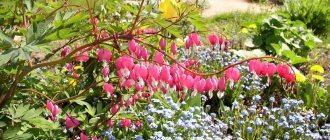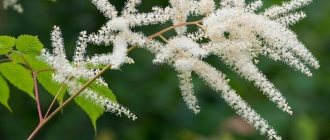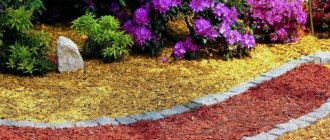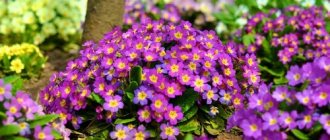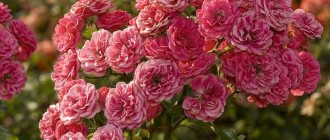And it seems that these simple flowers accompanied man throughout his history. In any case, archaeologists claim that flax seeds and flaxseed oil were already known in the Bronze and Iron Ages. The ancient Egyptians cultivated flax to weave linen, and the Romans considered this plant a symbol of purity, light and fidelity.
Description and properties of flax
The perennial herbaceous crop is often found in the middle zone. It is a small upright bush with a vertical root system. The thin stems are quite strong, up to 0.8 m high, covered with thin narrow-lanceolate leaves measuring no more than 50x3 mm. During flowering, the plant throws out five-petal baskets with a diameter of about 3 cm. Their color is varied and depends on the variety. By autumn, in place of faded buds, elongated boxes filled with oily seeds form.
Flax is a perennial herbaceous crop
In addition to its decorative qualities, flax has medicinal properties:
- increases immunity;
- stabilizes blood pressure;
- prevents the formation of blood clots;
- speeds up metabolism;
- reduces blood cholesterol levels;
- removes toxins;
- helps fight depression.
Maturation period
Flax has three types of ripening depending on the variety:
- early variety
- mid-season
- late ripening.
The average duration of the growing season ranges from 70 to 100 days. At a temperature of 3-5 degrees Celsius, the seeds begin to germinate. Young seedlings tolerate frosts down to -5 °C well. Cloudy weather with a temperature range of 15-18 °C is most suitable for growing thin, tall plants. The plant does not tolerate sudden changes in temperature.
Popular types with photos
Today, botany has discovered about 200 varieties of flax. Of these, only a few are adapted to garden conditions.
Decorative
A herbaceous perennial with thin stems 0.5-0.6 m long, which are covered with light brown bark closer to autumn. This variety blooms from June to October, producing blue or cornflower blue five-petalled baskets with a diameter of about 50 mm.
Large-flowered
A medium-sized plant 0.4-0.6 m high with vertical, branching shoots. Flowering occurs from June to September. During this period, the bush is covered with bright buds measuring 50-60 mm. The most common colors are snow-white, crimson or lilac.
Ordinary
The most unpretentious species, able to withstand harsh winters and dry periods. Grows up to 0.6 m, blooms from June to August. The stems are thin, branched, covered with narrow-lanceolate leaves. Inflorescences are about 30-40 mm in size, sky blue.
perennial flax
A branched bush up to half a meter high with thin but strong branching shoots. The leaves are small, oppositely located. During flowering, which occurs in the first half of summer, it produces small (up to 20 mm) pale blue baskets.
Perennial heavenly
An erect herbaceous plant growing up to 0.5 m. The stems are flexible, densely leafy, and become woody over time. During the flowering period, miniature (no more than 2 cm) five-petal buds in the shade of the summer sky appear on the bushes.
Red
A compact flower, which is a bush 0.5 m high and 0.2 m wide. Flowering lasts from late spring to mid-autumn. At this time, the plant produces large (30-40 mm) buds of rich red or carmine color.
Decorative
Large-flowered
Ordinary
perennial flax
Perennial heavenly
Red
Production
In 2014, world production of flax (flaxseed) amounted to 2.65 million tons, with Canada taking first place with 33% of total production. Other major producers are Kazakhstan, China and Russia.
Maturation
Flax is harvested for fiber production approximately 100 days or a month after the flowers appear and two weeks after the seed capsules form. The bases of the plants begin to turn yellow. If the plants are still green, the seeds will not be useful and the fiber will not be developed enough. The fiber is destroyed when the plants turn brown. Cultivated for its seeds, flax ripens until the seed capsules turn yellow and begin to split, at which point it is harvested in a variety of ways. The harvester can cut either just the plant heads or the entire plant. The cut plants are then dried to extract the seeds. The amount of weeds in the straw affects its profitability and this, combined with market prices, determines whether the farmer will harvest the flax straw. If flax straw is not collected, as a rule, it is burned, since the stalks are quite tough and decompose slowly (that is, not in one season). Formed into rolls during the harvesting process, straw often clogs tillage and planting equipment. Flax straw, which is not of sufficient quality to be used as fiber, may be baled to build shelters for farm animals or sold as biofuel or removed from the field in the spring. Two methods are used to collect flax fiber: one of them is associated with mechanized equipment (combines), and the second method is more manual and focused on the maximum length of the fiber.
Planting and growing in open ground
The unpretentious perennial does not require special care, and therefore can be safely planted in the country house or in the garden without fear that it will suffer from lack of attention. To make the flower comfortable, it is enough to follow the minimum agrotechnical rules.
Selection of location and soil
Flax feels best in open areas where the sun's rays reach unhindered. Flowers should not suffer from lack of light, excess moisture and groundwater located close to the surface. The soil for the plant is nutritious, loose, and well-drained.
To maximize the decorative qualities of the perennial, gardeners recommend planting it on loamy soils.
Author's advice
Preparing and sowing seeds
Flax is frost-resistant, and therefore sowing can be done in early spring or late autumn. Most often, the crop is sown directly into open ground. To do this, fertilize the soil in advance and prepare the seeds. First, they are treated with antifungal drugs and then treated with growth stimulants.
Immediately before planting, shallow grooves are formed at intervals of at least 0.2 m from each other. Seed material is laid out in them, well moistened and sprinkled with soil. After the first shoots hatch, pick, leaving 9-12 cm between the seedlings.
Germinating perennial seeds in open ground
Some summer residents prefer to plant seeds for seedlings. They do this as follows:
- a drainage layer of expanded clay is laid on the bottom of the container, and a nutrient substrate is poured on top;
- planting material is sown evenly, which is then moistened with a spray bottle;
- cover with a centimeter layer of soil and cover with cling film, ventilating the seedlings daily;
- as soon as the first shoots appear, the polyethylene is removed;
- After the formation of a pair of full-fledged leaves, the seedlings are planted in separate cups.
Plant care
Growing flax in the garden does not require much effort. In order for a perennial to bloom profusely and not get sick, it needs to create conditions that are comfortable for growth. So, the soil under the bushes should not be allowed to dry out. To do this, flowers are provided with regular, abundant watering. Irrigation is carried out in the morning using settled rainwater. Immediately after the procedure, the soil is carefully loosened, removing sprouted weeds.
Feed flax three times per season:
- upon disembarkation;
- during active growth;
- before flowering begins.
Mineral complexes for flowering crops and organic matter are used as fertilizers.
Table: Scheme for applying fertilizers to the soil
The perennial is not covered for the winter. After flowering, dried buds are cut off from the bush, watering is minimized, and after the onset of cold weather, spruce branches or dry leaves are thrown on top.
Germination of seeds
Sprouted flax seeds have long been considered a product that has a healing effect, so by germinating flax at home for planting, you can combine business with pleasure.
A flax seed sprout is a green shoot that, through the process of photosynthesis, receives energy for growth, as well as all the beneficial vitamins and minerals. At the moment of seed germination, its adaptation begins, so in order to get strong seedlings that will give a good harvest in the future, you need to know how to germinate flax seeds correctly:
- When carrying out the germination process, you will need potassium permanganate for disinfection, as well as a wide-necked jar, water, and a sieve.
- Before the disinfection process, flax seeds should be poured into a jar and filled with cold water. Dry seeds that float to the surface should be removed. In this way, it will be possible to weed out the bad grains.
- During the soaking process, flax seeds produce mucilage, which must be removed by repeatedly washing the seeds.
- The selected seeds should be dipped into a soft pink solution of potassium permanganate for 20 minutes.
- Rinse the seeds under water and pour hot (60 degrees).
- After the water has cooled, add 1 tbsp. l. complex of minerals. Soak in the composition for 1 hour.
- Now you can begin the germination process: take a small grid, put a cloth on it, and place a thin layer of seeds on top. Spill with water. Water will gradually drain from the grate.
- Keep the container with a grill on the sunny side at a temperature of 24 degrees.
- Germination takes place within 4 days. The container is left in the refrigerator overnight to harden the seed. This will make it possible to plant the seeds in the soil, which has only warmed up to 2 degrees.
- Laying in the ground is carried out at a depth of 3 cm.
Such sowing measures will help increase the frost resistance of perennial flax species.
How does a plant reproduce?
In addition to seed, gardeners often use two more methods of flax propagation: cuttings and dividing the bush.
Cuttings
The procedure is carried out at any time from the second half of April to the very end of summer. It consists of several stages:
- shoots 20 cm long are separated from an adult bush;
- plant them in the ground at the level of the lower leaves;
- the top is slightly shortened, and then the cutting is covered with a jar;
- Before new foliage appears, daily ventilation and moistening are carried out.
Rooting of the seedling occurs in autumn or early spring.
Dividing the bush
The easiest way, which is suitable for the period before budding or after the end of flowering. The procedure algorithm is simple:
- the mother plant is dug up and the roots are cleared from the ground;
- carefully divide the perennial into parts, which are immediately planted nearby, maintaining a distance of 0.2 m;
- Then the separated bushes are cared for as if they were adult plants.
Decorative flax
Pickling recipe. Technologist…
Gas stoves - characteristics, features. Personal experience. Review…. Choosing a gas stove. What parameters should I focus on? What would you rather give...
Fried dandelion roots - preparation. Ingredients, composition. Diet... How to fry dandelion roots. Personal experience. Advice. Detailed instructions. Great…
Growing Stachys (sheep's woolly ears) - planting tips. Soil,... How to plant and grow strawberries. How to choose soil. How to plant, propagate,...
Diseases and pests of flax
The wildflower is quite resistant to infections, but if poorly cared for it can be susceptible to a number of dangerous diseases:
- fusarium - yellowing and drying of the aerial parts;
- rust - the appearance of orange-brown areas on the plant;
- polysporosis - browning of the root zone with further wilting of the flower;
- anthracnose - seedlings become covered with rusty spots turning into ulcers;
- pasmo - appears as pale yellow, transparent spots on the leaves;
- ascochyta blight - spreads to the stems, making them brittle;
- gray mold - also affects the shoots, forming dark growths on them.
Signs of a plant being affected by rust
All these fungal diseases can be prevented by treating the seed with Granosan. Treatment with fungicides, such as Fundazol or Fitosporin, will help overcome an existing infection.
However, there are problems that cannot be treated. These include viral and bacterial diseases:
- mottling of cotyledons - the appearance of red-brown specks, which over time turns into a solid brown spot;
- bacteriosis - affects the root zone of the stem, which very quickly thins and rots.
Affected specimens are uprooted and then burned. Neighboring bushes are treated with copper-containing preparations to prevent infection.
Pests often settle on perennials:
- thrips;
- fleas;
- weevils;
- centipedes;
- codling moths;
- scoops;
- moths.
To prevent insects from harming the crop, it is regularly sprayed with an insecticide solution (for example, Aktara or Aktellik).
Rich palette for a picturesque flower garden
Areca chrysalidocarpus features of care and cultivation
Decorative flax will enliven a flower bed, mixborder, alpine slide, rock garden. Perennial herbaceous representatives and subshrubs are popular, but annual species are no less beautiful. You don’t have to limit yourself to just blue; contrary to traditional ideas, linen can surprise you with its stunning colors.
Red flax, beloved by many gardeners, blooms in early summer and delights with scarlet inflorescences until September. Alpine and Austrian species are low, 30-40 centimeters, bloom blue.
There is also a very unusual yellow flax; golden accents are good in composition with other plants. Narbonne flax looks gorgeous; the beauty of the original bright blue inflorescences is emphasized by the snow-white center. This species branches and blooms in July-August. There are species with white, pink and purple inflorescences.
What color is linen
In Russia, flax has been grown since time immemorial. At the beginning of the 18th century, even a horseless peasant set aside a strip of linen, which he “clothed, treated and fed.” On November 10, according to the new style, on the day of Paraskeva, flax in the villages began to crush and fray flax, preparing it for yarn; they took them out for display and organized “linen shows”.
Flax yellow
Coarse flax
Veined flax
Driving through the territory of the Kursk region last year, we came across a small field of unusual pale blue color - this was the blooming flax (Linum usitatissimum L.). Rarely, flax is also grown in our region. But there are many wild flax species in the Kursk region: yellow flax (Linum flavum L.), stiff flax (Linum hirsutum L.), veined flax (Linum nervosum Waldst. et Kit.), perennial flax (Linum peretne L.), flax Ukrainian (Linum ucrainicum (Griseb. ex Planch.) Czern.) and laxative flax (Linum catarthicum L.). Yellow flax - a plant 15-60 cm in height, with numerous flowers collected in corymbose inflorescences, grows in the steppes, in forest clearings, in chalk outcrops; unpretentious and decorative. Coarse-haired flax is the largest-flowered flax with characteristic long-haired pubescence of stems, grows along chalk outcrops, on steppe edges; in the Kursk region, the only known location is in the Gorshechensky district. Perennial flax with bright blue flowers and veined flax with lilac flowers grow in the steppes, meadows, forest glades, fallow lands and chalk slopes. Ukrainian flax, which, like coarse flax, is located in the Kursk region on the northern border of its range, grows in the Gorshechensky and Manturovo regions. Flax laxative is a small annual plant (8-15 cm) with small white (5 mm) flowers with a yellow center; grows in meadows, bushes and clearings. On the territory of the Central Chernozem Reserve, sections of which are located in six regions, all types of flax are found, except for hard flax, which grows along with other rare plants only in the upper reaches of the Borovaya Potudan ravine, Gorshechensky district, where it is imperative to create a natural monument. Perennial wild flax: yellow, hard-haired, veined, perennial and Ukrainian are included in the Red Book of the Kursk region.
Perennial flax
Ukrainian flax
Perennial flax for training. Zorinsky
The flax genus (Linum L.) is the largest in the flax family; about 230 species are known in the world from temperate and subtropical regions of both hemispheres; Herbaceous perennial herbs predominate among them, but there are also shrubs, such as tree flax (Linum arboreum L.), growing in Greece and southwest Asia. All flax flowers have five sepals and five petals; in addition to the five developed stamens, there are five underdeveloped ones in the form of denticles or threads; the fruit is a dry capsule with ten seeds.
Veined flax in the Streletskaya steppe
Yellow flax on account Barkalovka
Perennial flax bolls
Zolotukhina I.B., Soshnina V.P.
Published 11/10/2013
